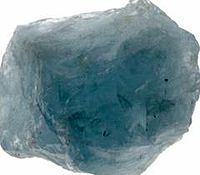Aquamarine (color)
Appearance
| Aquamarine | |
|---|---|
| Hex triplet | #7FFFD4 |
| sRGBB (r, g, b) | (127, 255, 212) |
| HSV (h, s, v) | (160°, 50%, 100%) |
| CIELChuv (L, C, h) | (92, 60, 158°) |
| Source | X11[1] |
| ISCC–NBS descriptor | Brilliant green |
| B: Normalized to [0–255] (byte) | |
| Aquamarine (RGB) | |
|---|---|
| Hex triplet | #00FFC0 |
| sRGBB (r, g, b) | (0, 255, 192) |
| HSV (h, s, v) | (165°, 100%, 100%) |
| CIELChuv (L, C, h) | (90, 83, 155°) |
| Source | [Unsourced] |
| ISCC–NBS descriptor | Vivid green |
| B: Normalized to [0–255] (byte) | |
| Medium aquamarine | |
|---|---|
| Hex triplet | #66CDAA |
| sRGBB (r, g, b) | (102, 205, 170) |
| HSV (h, s, v) | (160°, 50%, 80%) |
| CIELChuv (L, C, h) | (76, 49, 158°) |
| Source | X11[1] |
| ISCC–NBS descriptor | Brilliant green |
| B: Normalized to [0–255] (byte) | |
Aquamarine is a color that is a light tint of teal, in between cyan and green on the color wheel. It is named after the mineral aquamarine, a gemstone mainly found in granite rocks. The first recorded use of aquamarine as a color name in English was in 1598.[2]
-
Rough aquamarine
-
Aquamarine crystals on muscovite
-
An aquamarine brooch

Carl Schmitz-Pleis (1877 - 1943): Lady in Aquamarine, 1911.
See also
References




